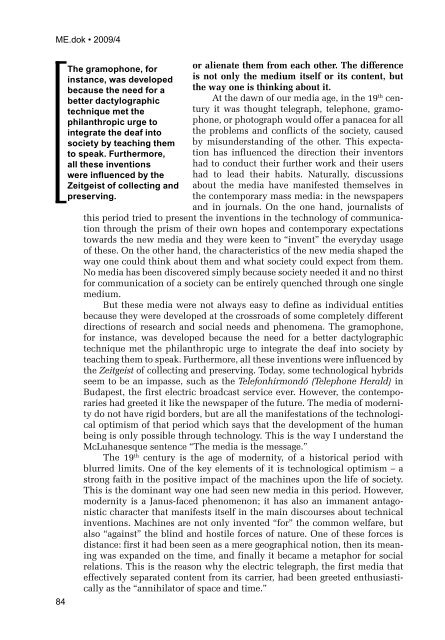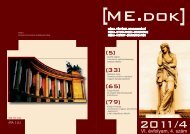A méhkas szelleme - ME.dok 2012/2
A méhkas szelleme - ME.dok 2012/2
A méhkas szelleme - ME.dok 2012/2
You also want an ePaper? Increase the reach of your titles
YUMPU automatically turns print PDFs into web optimized ePapers that Google loves.
<strong>ME</strong>.<strong>dok</strong> • 2009/4<br />
84<br />
or alienate them from each other. The difference<br />
is not only the medium itself or its content, but<br />
the way one is thinking about it.<br />
At the dawn of our media age, in the 19th century<br />
it was thought telegraph, telephone, gramophone,<br />
or photograph would offer a panacea for all<br />
the problems and conflicts of the society, caused<br />
by misunderstanding of the other. This expectation<br />
has influenced the direction their inventors<br />
had to conduct their further work and their users<br />
had to lead their habits. Naturally, discussions<br />
about the media have manifested themselves in<br />
the contemporary mass media: in the newspapers<br />
and in journals. On the one hand, journalists of<br />
this period tried to present the inventions in the technology of communication<br />
through the prism of their own hopes and contemporary expectations<br />
towards the new media and they were keen to “invent” the everyday usage<br />
of these. On the other hand, the characteristics of the new media shaped the<br />
way one could think about them and what society could expect from them.<br />
No media has been discovered simply because society needed it and no thirst<br />
for communication of a society can be entirely quenched through one single<br />
medium.<br />
But these media were not always easy to define as individual entities<br />
because they were developed at the crossroads of some completely different<br />
directions of research and social needs and phenomena. The gramophone,<br />
for instance, was developed because the need for a better dactylographic<br />
technique met the philanthropic urge to integrate the deaf into society by<br />
teaching them to speak. Furthermore, all these inventions were influenced by<br />
the Zeitgeist of collecting and preserving. Today, some technological hybrids<br />
seem to be an impasse, such as the Telefonhírmondó (Telephone Herald) in<br />
Budapest, the first electric broadcast service ever. However, the contemporaries<br />
had greeted it like the newspaper of the future. The media of modernity<br />
do not have rigid borders, but are all the manifestations of the technological<br />
optimism of that period which says that the development of the human<br />
being is only possible through technology. This is the way I understand the<br />
McLuhanesque sentence “The media is the message.”<br />
The 19th The gramophone, for<br />
instance, was developed<br />
because the need for a<br />
better dactylographic<br />
technique met the<br />
philanthropic urge to<br />
integrate the deaf into<br />
society by teaching them<br />
to speak. Furthermore,<br />
all these inventions<br />
were influenced by the<br />
Zeitgeist of collecting and<br />
preserving.<br />
century is the age of modernity, of a historical period with<br />
blurred limits. One of the key elements of it is technological optimism – a<br />
strong faith in the positive impact of the machines upon the life of society.<br />
This is the dominant way one had seen new media in this period. However,<br />
modernity is a Janus-faced phenomenon; it has also an immanent antagonistic<br />
character that manifests itself in the main discourses about technical<br />
inventions. Machines are not only invented “for” the common welfare, but<br />
also “against” the blind and hostile forces of nature. One of these forces is<br />
distance: first it had been seen as a mere geographical notion, then its meaning<br />
was expanded on the time, and finally it became a metaphor for social<br />
relations. This is the reason why the electric telegraph, the first media that<br />
effectively separated content from its carrier, had been greeted enthusiastically<br />
as the “annihilator of space and time.”



